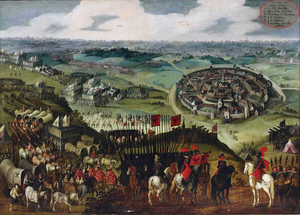| Siege of Aachen | |||||||
|---|---|---|---|---|---|---|---|
| Part of War of the Jülich Succession | |||||||
 The siege of Aachen by the Spanish Army of Flanders under Ambrogio Spinola in 1614. Oil on canvas. Attributed to Peter Snayers. | |||||||
| |||||||
| Belligerents | |||||||
|
Free Imperial City of Aachen Margraviate of Brandenburg | Spanish Empire | ||||||
| Commanders and leaders | |||||||
| George von Pulitz | Ambrosio Spinola | ||||||
| Strength | |||||||
| 600 regulars | 15,000[1] | ||||||
| Casualties and losses | |||||||
| None | None | ||||||
The siege of Aachen took place in 24 August 1614, when the Spanish Army of Flanders, led by Ambrogio Spinola, 1st Marquis of the Balbases, marched from Maastricht to Germany to support Wolfgang Wilhelm, Count Palatine of Neuburg, during the War of the Jülich Succession.[1][2] Despite its status as a free imperial city, Aachen was under the protection of John Sigismund of Brandenburg, Neuburg's ally, and then rival, in the battle for the United Duchies of Jülich-Cleves-Berg.[3] In 1611, the Protestant population of Aachen had revolted against the Catholic city council and had seized power. When the Holy Roman Emperor Rudolf II, observing the Peace of Augsburg, had ordered the previous state to be restored, the Protestants had allied themselves with the Margraviate of Brandenburg. The unexpected arrival of a Spanish army at the gates of the city, however, caused the Protestants to lose courage and surrender Aachen to Spinola. A Catholic garrison was installed and a process of re-Catholicization began.
